Contents
- What is the Euro Mountain Sheparnese?
- A Brief Overview of the Bernese Shepherd
- Why a Bernese Shepherd May Be Right For You
- Why a Bernese Shepherd May Not Be Right for You
- What This Gentle Giant Looks Like
- How Big Can a Bernese Shepherd Get?
- Who is the Bernese Shepherd?
- Caring for this Crossbreed
- Trainability Factor
- Are There Health Problems?
- Is a Bernese Shepherd Right for You?
- Other German Shepherd Mixes
Are you looking for a special dog to make your family complete? The Bernese Shepherd can be a wise choice if you have the space for a larger canine.
The Euro Mountain Sheparnese, or the Bernese Shepherd, is a rare crossbreed. This dog combines the loyal and protective German Shepherd with the good-natured, calm Bernese Mountain dog. These pups make excellent watchdogs and even better family companions.
In this article, you will learn and understand the Bernese Shepherd. It will give you training, grooming, socialization, and exercise information. Read on to learn more about the Bernese Shepherd.
What is the Euro Mountain Sheparnese?
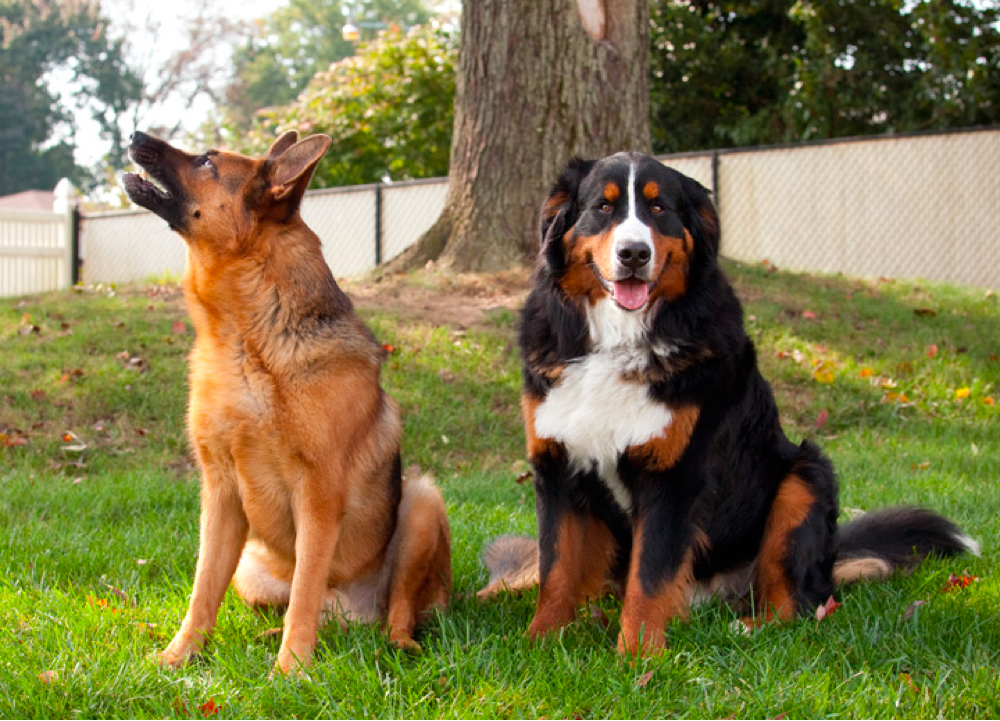
The Euro Mountain Sheparnese is a wonderful crossbreed consisting of the German Shepherd dog and the Bernese Mountain dog. The dog may also be called a Bernese Shepherd. The Bernese Mountain dog is a large canine breed, and the German Shepherd is a large dog breed.
When you crossbreed the German Shepherd and the Bernese Mountain dog, you will get a Bernese Shepherd. To better understand the Bernese Shepherd, you must look at the history of each of the two parent breeds:
1. German Shepherd History
The German Shepherd dog has a long and rich history, dating back to 1889 when Captain Max von Stephanitz set out to propagate the perfect working dog and family companion. Von Stephanitz attended a dog show in Germany and was immediately drawn to a sheepdog, whom he purchased and named Horand von Grafrath, and he was the first registered German Shepherd.
The first German Shepherd came to America in 1907, and in 1908, The American Kennel Club recognized the breed. The original purpose of the German Shepherd was to herd and protect sheep. Throughout the years, the GSD has had many roles as a working dog. They worked in the military, serving primarily as messengers and helping soldiers to communicate on the battlefield.
German Shepherds became trusted police workers who helped with search and rescue and bomb and drug detection. They also became service dogs, helping the blind and disabled. The German Shepherd dog has a good reputation for their work ethic and fierce loyalty to their families.
2. Bernese Mountain Dog History
The Bernese Mountain dog is an ancient breed, descending from crossbreeds of Mastiffs and guard dogs. They originated in Switzerland about 2,000 years ago, specifically in the city of Berne. These dogs were utilized for pulling carts on farmland, herding cattle, and protecting the farm from predators. Some Swiss farmers also had BMDs haul or carry items like fresh milk to the local dairy.
The Bernese Mountain dog was not only valuable to farmers but they were also cherished family companions. These dogs continued to work on farms until the 1800s. The breed was brought to America in 1926 and was acknowledged by The American Kennel Club in 1937. The Bernese Mountain dog can be used for herding and therapy and make excellent family dogs.
A Brief Overview of the Bernese Shepherd
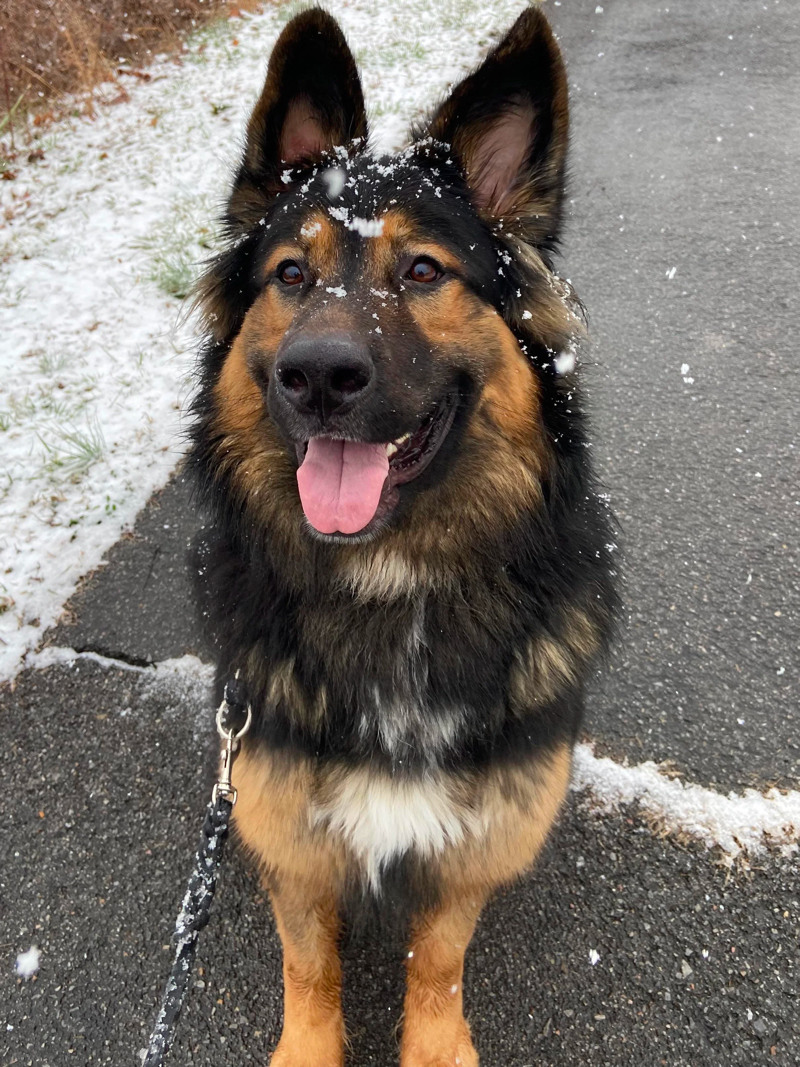
The Bernese Shepherd is a massive dog with similar attributes to the two parent breeds. These dogs are gentle giants with characteristics like protectiveness and good-natured calmness. This crossbreed loves to work and enjoys their life when they have a specific task.
| SHEPARNESE FACTS | MALE | FEMALE |
| Height at Maturity | 25 – 28 inches | 23 – 26 inches |
| Weight at Maturity | 80 – 110 pounds | 75 – 90 pounds |
| Lifespan | 9 – 12 years with an average of 10 | 9 – 12 years with an average of 10 |
| Colors | Brown, blue, gray, black, and cream | Brown, blue, gray, black, and cream |
| Temperament | High energy, running, playing | High energy, running, playing |
| Perfect For | Families | Families |
| Shedding | More than average not hypoallergenic | More than average not hypoallergenic |
| Eyes | Brown | Brown |
| Ears | Similar to Bernese | Similar to Bernese |
| Coat | Double coat, med length dense and straight | Double coat, med length dense and straight |
As you can see from this chart, Bernese Shepherds have various features depending on whether they are male or female. Some of the specifications are similar for both, but some are different. The eyes, ears, coat, and temperament of the male and female are the same.
Why a Bernese Shepherd May Be Right For You
There are advantages to each breed. The Bernese Shepherd has some good attributes that make them desirable to dog owners. The following includes reasons why the Bernese Shepherd may be right for you:
1. Good Family Companion
Bernese Shepherd dogs tend to have the protective traits of the German Shepherd and the laid-back, calm spirit of the Bernese Mountain dog. These pups also love to play, which makes them ideal for young children. They may have the same activity level as the German Shepherd combined with the patience of a Bernese Mountain dog.
If Bernese Shepherds are adequately trained and socialized, they also get along with other canines and cats. Both German Shepherds and Bernese Mountain dogs are affectionate and gentle. They love their families and enjoy cuddles and big teddy bear hugs. These dogs also make good watchdogs, and the family will always be safe with these canines living in the home.
2. Hardworking and Diligent
Both German Shepherds and Bernese Mountain dogs are known to be hardworking and diligent. Bernese Mountain dogs can perform many jobs, such as herding and therapy. German Shepherds are outstanding workers. They excel in many areas, including:
- Police work
- Military work
- Herding
- Therapy
German Shepherds and Bernese Mountain dogs are also great at protecting families or estates from intruders. GSDs may also be utilized to work in airports to perform many of the duties they would in police work. The Bernese Mountain dog can be trained in drafting or pulling carts. The crossbreed is born from a long line of hardworking canines and exceptional character.
3. Easy to Train
Both German Shepherds and Bernese Mountain dogs are easy to train. Bernese Shepherds have the right personality to excel in training and become extremely well-behaved and obedient dogs:
- Eager to please their master
- Responsive to commands
- Highly intelligent and alert
- Love a good challenge
Bernese Shepherds also learn quickly, so it is a pleasure to teach them. The two parent breeds are also known for being skilled at more complex and involved obedience training.
Why a Bernese Shepherd May Not Be Right for You
There are disadvantages to each breed. It depends on what you are looking for. The Bernese Shepherd has many attributes, but there are some reasons why they may not be the right dog for you:
1. Relatively Short Lifespan
The average lifespan for larger dog breeds overall is 8 to 12 years. However, you must look at the two parent breeds to know how long a Bernese Shepherd typically lives. Bernese Mountain dogs have a shorter lifespan than German Shepherds due to their larger size. Bernese Mountain dogs generally live for about 6 to 9 years.
German Shepherds usually live for about 7 to 10 years. The combination of the genes of the two parent breeds in the crossbreed will sometimes allow for a longer lifespan of about 9 to 12 years. This increase is due to a process called hybrid vigor, which is when the performance of an individual trait is improved in the first cross-generation over the parent generation.
However, the Bernese Shepherd tends to live about ten years on average, which is still less than most dog breeds. It has been concluded that larger dogs often have shorter lifespans because they age more quickly, meaning their larger bodies wear down faster than smaller breeds. This factor should be considered when thinking about the Bernese Shepherd.
2. Requires a Lot of Space
The Bernese Shepherd requires a lot of space to roam around and exercise. A larger dog like a Bernese Shepherd may not be happy if you live in a smaller space like an apartment or a townhouse. If you do not have a spacious backyard for them to exercise, it is simply not fair to the dog. The large size of the dog can also be intimidating for first-time dog owners.
3. They Prefer to Live in Cooler Climate
Bernese Shepherds prefer cooler climates, as Bernese Mountain dogs were bred for cold weather conditions. They originated in Switzerland, which is a cold, snowy environment. Bernese Shepherds will likely have thicker coats that will overheat more easily, as the coat was meant to protect them from a harsher, colder climate. Some ways to keep Bernese Shepherd cool:
- Make sure they keep hydrated with plenty of water
- Avoid walking them on hot surfaces like concrete
- Give them access to an air-conditioned room
- Exercise them at the right time of day
You should exercise your Bernese Shepherd early in the morning or later in the evening. Bernese Shepherds will likely have difficulty in the heat, which is not good news for someone who lives in a hotter climate and wants to get a Bernese Shepherd. The Bernese Shepherd may be unable to tolerate heat exceeding 75 degrees Fahrenheit.
What This Gentle Giant Looks Like
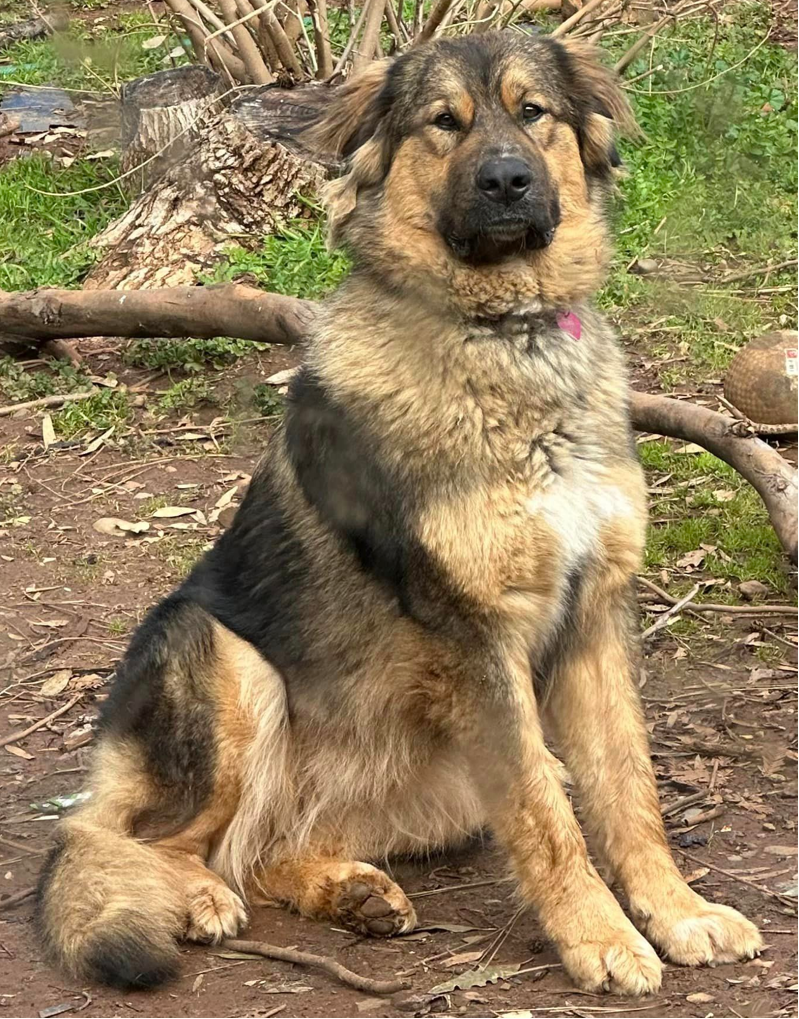
A Bernese Shepherd will likely resemble a combination of the two parent breeds, the Bernese Mountain dog and the German Shepherd. Some puppies will look closer to a German Shepherd, while other puppies will look like the Bernese Mountain dog. It will depend on which parent the puppy resembles, the mother or the father.
For example, the puppy may have more of the coat type and fur coloring closer to their German Shepherd mother but the floppy ears of their Bernese Mountain dog father. The puppy’s appearance will depend on whichever parent has the dominant genes. The following includes some ideas as to what the Bernese Shepherd looks like:
1. The Face
The Bernese Mountain dog has a skull that is flat on top of the head. The face is strong and well-defined. They have distinctive white and rust markings on their face. German Shepherds have long faces and friendly, approachable expressions. Bernese Shepherds may have a combination of both. The Bernese Shepherd may inherit the hardiness of the Bernese Mountain dog, but they may also have the softer characteristics of the German Shepherd.
2. The Ears
German Shepherds have pointy ears, and Bernese Mountain dogs have floppy ears. A German Shepherd is born with ears that are down. The cartilage and muscles are not strong enough or fully formed for the ears to stand erect. Their ears go up when they reach four to five months of age.
Bernese Mountain dogs have floppy ears that are down. A Bernese Shepherd may have pointy ears, but they are likelier to have floppy ears like that of a Bernese Mountain dog. The ears of the crossbreed may also have ears that are feathered in appearance.
3. The Eyes
German Shepherds are born with blue eyes, but when they get older, their eyes are brown. If the color remains blue into adulthood, it is considered a defect in the dog. The American Kennel Club disqualifies most purebred blue-eyed dogs from dog shows.
Bernese Mountain dogs have brown eyes. It is rare for a BMD to have blue eyes, as this is different from the breed standard. Therefore, Bernese Shepherds typically have brown almond-shaped eyes. Blue eyes are a potentially recessive trait in either of the parent breeds.
How Big Can a Bernese Shepherd Get?
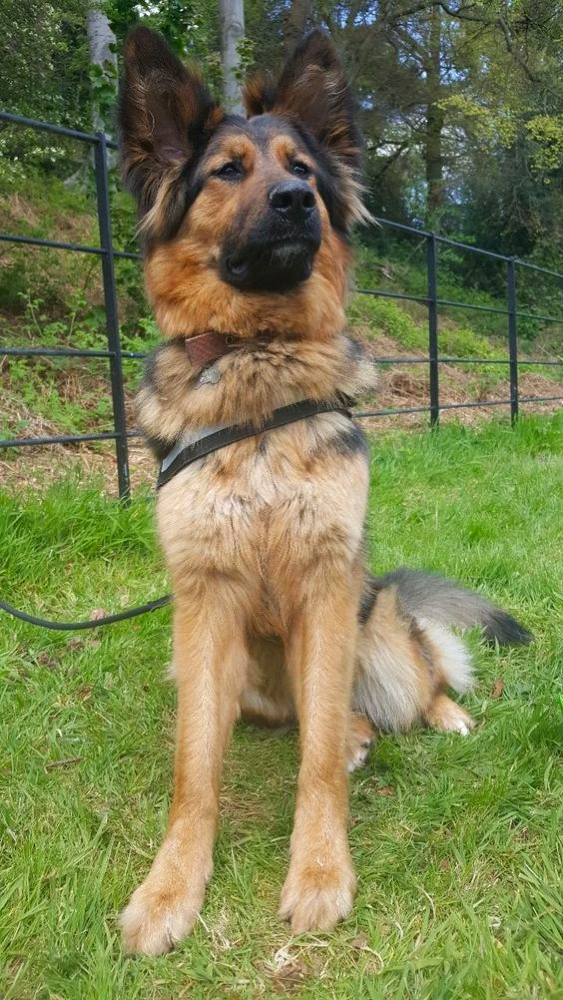
Referring to the chart, Bernese Shepherds are of different weights and heights depending on whether they are male or female. Males are 25 to 28 inches tall, whereas females are 23 to 26 inches in height from paw to shoulder. Bernese Shepherd males usually weigh 80 to 110 pounds, and females weigh 75 to 90. These dogs tend to be larger than GSDs but smaller in stature compared to BMDs.
Who is the Bernese Shepherd?
The Bernese Shepherd is a loyal, protective, and good-natured four-legged friend with a great personality and temperament. They are wonderful companions for anyone looking for a larger pup to add to the family. The following describes the Bernese Shepherd:
- Gentle
- Playful
- Powerful
- Easygoing
- Intelligent
- Affectionate
- Hardworking
- Courageous
The above characteristics represent the crossbreed’s stellar disposition. Bernese Shepherds tend to fall in love with their families and are eager to please their humans. They often have some of the traits of the German Shepherd and characteristics of the Bernese Mountain dog.
Caring for this Crossbreed
This crossbreed requires a lot of care. The Bernese Shepherd tends to be soft and fluffy, necessitating a thorough brushing. You need the time and patience to put in the work it takes to care for them properly. The following is advice to care for your Bernese Shepherd.
1. Coat Color and Type
Bernese Shepherds typically have thick, silky, medium-length double coats. These pups resemble the Bernese Mountain dog more closely, as their coats are denser. The coat colors usually range from brown, blue, gray, black, and cream. Bernese Shepherds shed more than average all year round and are not hypoallergenic.
2. Practice Good Grooming Habits
Bernese Shepherds require daily brushing to remove all the knots and create a silky, shiny, and healthy coat. You must brush their teeth 2 to 3 times a week, as these dogs are prone to dental problems. These pups should have their nails clipped about every three to four weeks.
You should bathe your Bernese Shepherds about every six to eight weeks. The undercoat is so thick and dense that extra care should be taken not to allow leftover soap to linger and cause mold, damaging their lustrous coat.
3. Diet and Nutrition Requirements
The Bernese Shepherd can eat between 4 to 5 cups of kibble daily, depending on the dog’s size. Kibble, high in protein, carbohydrates, vitamins, and minerals, is ideal for proper nutrition. Beware of additives, as they can trigger behavioral issues. Both parent breeds are prone to food sensitivities and allergies, so be cautious and discuss the best options for your dog with your veterinarian.
4. How Much Physical Activity They Need
The Bernese Shepherd will likely take after the German Shepherd in this area, requiring at least one hour a day of quality exercise to keep them physically fit and healthy. Some of the activities the Bernese Shepherd may enjoy:
- Hiking
- Running
- Catch
- Agility
You should walk your dog twice daily for about a half hour each time. However, these dogs will need a variety of activities to keep them mentally stimulated and happy. The Bernese Shepherd loves to play, especially when it involves their favorite humans.
Trainability Factor
The Bernese Shepherd is easy to train, as they are eager to please their humans. They can learn commands quickly and are excellent listeners. Due to their guarding and protective instincts, you should train and socialize them early to prevent guests in your home from being treated like intruders.
The crossbreeds’ Bernese Mountain dog lineage makes them expert pullers, and they may be known to pull on their leash, but you can train them to be less inclined to do so. Forming a strong bond with your dog is essential to make training more straightforward and fun for both of you. You can even let the kids get involved with training once you feel your pup is ready and behaving appropriately.
Are There Health Problems?
Bernese Shepherds are prone to developing health issues affecting either parent breed. German Shepherds have their health afflictions, and Bernese Mountain dogs can have similar health challenges:
- Hip and Elbow dysplasia- occurs when the pup’s joints are not developed correctly. There may be lameness in the hind legs and difficulty standing. They may also have a limited range of motion or enlargement in the shoulder area.
- Gastric dilatation and volvulus- often referred to as bloat, in larger dogs are more at risk due to their deep chests. An enlargement or twisting of the stomach characterizes the condition. Dogs can get life-saving surgery to correct the condition and prevent it from happening again.
- Progressive retinal atrophy- is a degenerative eye disease that eventually leads to blindness. It often begins with signs of night blindness. The progression of the disease is slow but not painful.
- Von Willebrand’s disease- is a blood clotting disorder that makes it difficult for blood to clot. It is caused by a lack of von Willebrand factor protein, which is necessary to control bleeding.
Larger breed dogs also have a higher risk of developing cancer at an early age. Regular veterinarian checkups can help to ensure conditions can be managed effectively.
Is a Bernese Shepherd Right for You?
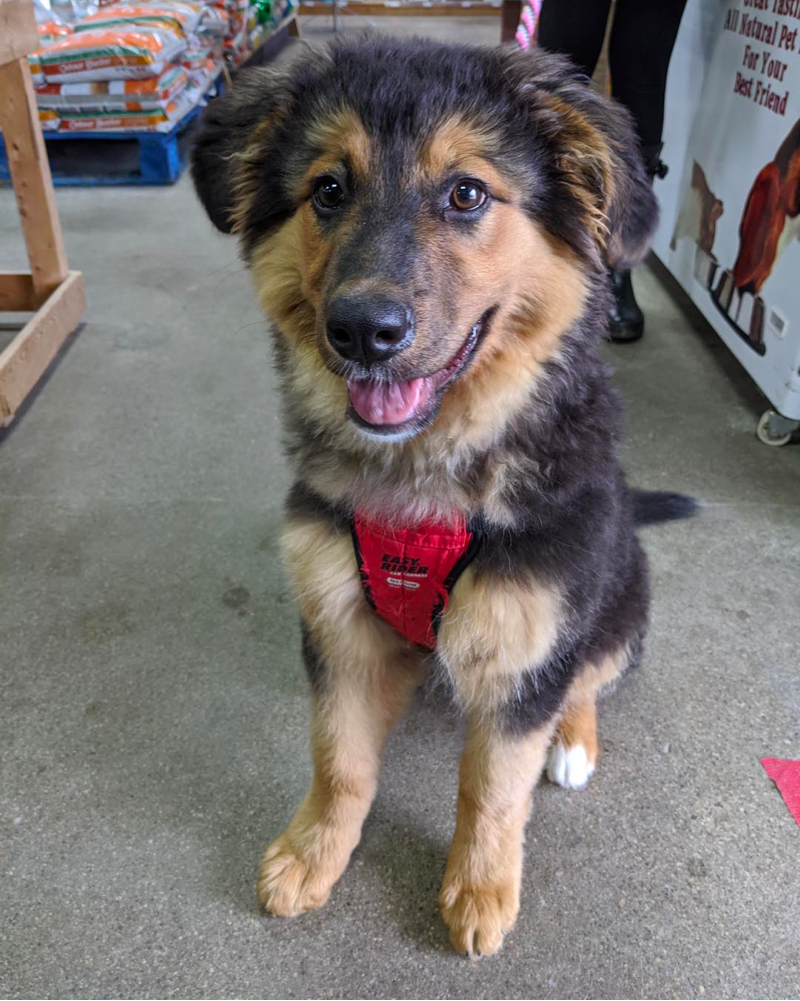
The Bernese Shepherd is a loyal, protective, good-natured family companion. The crossbreed is large, and you should ensure you have enough room in your home for them. These dogs require a fair amount of grooming, exercise, socialization, and training. If you are searching for a dog that will make your family complete, consider opening your heart to the Bernese Shepherd.

 Great Dane German Shepherd Mix: Playful, Friendly, Protective, and Faithful
Great Dane German Shepherd Mix: Playful, Friendly, Protective, and Faithful